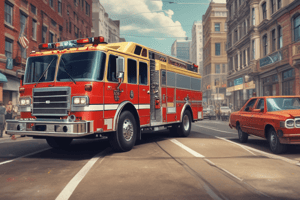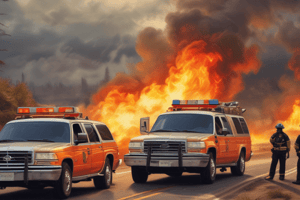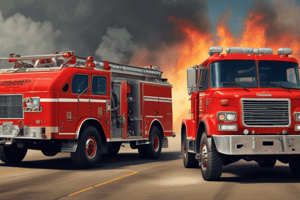Podcast
Questions and Answers
What is the most common type of terrorist attack worldwide?
What is the most common type of terrorist attack worldwide?
- Biological attacks
- Explosive attacks (correct)
- Incendiary attacks
- Nuclear attacks
What is the purpose of secondary devices in terrorist attacks?
What is the purpose of secondary devices in terrorist attacks?
- To distract from the primary device
- To target the public
- To target the first responders (correct)
- To create more destruction
Which of the following is NOT one of the five basic categories of terrorist incidents?
Which of the following is NOT one of the five basic categories of terrorist incidents?
- Nuclear
- Biological
- Radiological (correct)
- Incendiary
Which of the following is an example of a terrorist incident involving an explosive device?
Which of the following is an example of a terrorist incident involving an explosive device?
What is the purpose of the Standard Operating Policies and Guidelines mentioned in the text?
What is the purpose of the Standard Operating Policies and Guidelines mentioned in the text?
What is the main challenge faced by the public and first responders mentioned in the text?
What is the main challenge faced by the public and first responders mentioned in the text?
What is the primary concern when dealing with a situation involving a bomb threat or discovered device?
What is the primary concern when dealing with a situation involving a bomb threat or discovered device?
Why is early implementation of a unified Incident Command System considered critical to the outcome of an incident?
Why is early implementation of a unified Incident Command System considered critical to the outcome of an incident?
What may dictate the need for federal assistance beyond the capability of local responders in incidents involving acts of terrorism?
What may dictate the need for federal assistance beyond the capability of local responders in incidents involving acts of terrorism?
Which agency becomes the lead agency in the event of a bomb threat or discovered device?
Which agency becomes the lead agency in the event of a bomb threat or discovered device?
What is one of the reasons for Special Operations Responders being trained?
What is one of the reasons for Special Operations Responders being trained?
What should the core staffing assignments in the Special Operations District consist of?
What should the core staffing assignments in the Special Operations District consist of?
What is the primary goal of establishing a unified Incident Command System?
What is the primary goal of establishing a unified Incident Command System?
What type of incident may initiate a Special Operations Response?
What type of incident may initiate a Special Operations Response?
Who can initiate a Special Operations Response?
Who can initiate a Special Operations Response?
What is considered a hazardous material incident?
What is considered a hazardous material incident?
When should a Special Operations Response be initiated for a liquid hazardous material release?
When should a Special Operations Response be initiated for a liquid hazardous material release?
What types of incidents are considered technical rescues?
What types of incidents are considered technical rescues?
What should fire rescue personnel do when dealing with technical rescues or hazardous materials incidents?
What should fire rescue personnel do when dealing with technical rescues or hazardous materials incidents?
What should be considered the highest priority in technical rescues or hazardous materials incidents?
What should be considered the highest priority in technical rescues or hazardous materials incidents?
What should the Incident Commander do upon arrival at the scene of a technical rescue or hazardous materials incident?
What should the Incident Commander do upon arrival at the scene of a technical rescue or hazardous materials incident?
What role do Special Operations officers play in large-scale incidents?
What role do Special Operations officers play in large-scale incidents?
What are Special Operations officers considered for the Department regarding hazardous materials events and special rescues?
What are Special Operations officers considered for the Department regarding hazardous materials events and special rescues?
What is the purpose of the Personnel Accountability Report (PAR)?
What is the purpose of the Personnel Accountability Report (PAR)?
In multi-story incidents, which area is considered the hot zone?
In multi-story incidents, which area is considered the hot zone?
Who is responsible for maintaining contact with Command for future assignments during a multi-story incident?
Who is responsible for maintaining contact with Command for future assignments during a multi-story incident?
What is the purpose of a Tactical Benchmark PAR?
What is the purpose of a Tactical Benchmark PAR?
During an evacuation signal, how should crews respond?
During an evacuation signal, how should crews respond?
What should happen if a Personnel Accountability Report (PAR) is incorrect for a company?
What should happen if a Personnel Accountability Report (PAR) is incorrect for a company?
Who will fill resources requested by the Incident Commander during an escalating incident?
Who will fill resources requested by the Incident Commander during an escalating incident?
What is the specific role of the Staging Officer during an escalating incident?
What is the specific role of the Staging Officer during an escalating incident?
What should crews do if they hear continuous blasts from air horns during an incident?
What should crews do if they hear continuous blasts from air horns during an incident?
What is the primary responsibility of an Accountability Officer during a multi-story incident?
What is the primary responsibility of an Accountability Officer during a multi-story incident?
What is the primary role of the Special Operations officer?
What is the primary role of the Special Operations officer?
How are divisions established at an incident scene?
How are divisions established at an incident scene?
What is the purpose of the Unit ID System?
What is the purpose of the Unit ID System?
What is the Task/Accountability Board used for?
What is the Task/Accountability Board used for?
What is the purpose of the apparatus identifiers on SCBAs?
What is the purpose of the apparatus identifiers on SCBAs?
Who is ultimately responsible for informing the Incident Commander of any variances from the initial crew assignments?
Who is ultimately responsible for informing the Incident Commander of any variances from the initial crew assignments?
What is the minimum crew size for operating within the hot zone?
What is the minimum crew size for operating within the hot zone?
What is the purpose of the Accountability Sector at the Command Post?
What is the purpose of the Accountability Sector at the Command Post?
What is the primary purpose of the Unit ID System, Telestaff, and Task/Accountability Board together?
What is the primary purpose of the Unit ID System, Telestaff, and Task/Accountability Board together?
In a large-scale incident, what is the responsibility of the Command Post Accountability Officer?
In a large-scale incident, what is the responsibility of the Command Post Accountability Officer?
Flashcards are hidden until you start studying
Study Notes
Incident Command System
- Early implementation of a unified Incident Command System (ICS) is critical to the outcome of the incident
- ICS directs and controls all agencies from one lead source, ensuring:
- One field command post
- Systematic and prioritized event handling
- Organized deployment of resources
- Multi-agency response
- Centralized focus on safety
Safety
- Emergency operations must be organized to be successful
- Safety cannot be overemphasized, especially in incidents involving acts of terrorism
- Risks to rescuers are great, including:
- Biological contamination
- Toxic atmospheres
- Structural collapse
- Secondary devices
Support Agencies
- In the event of a large-scale incident, state and federal assistance may not arrive until 24-72 hours after the event
- Support agencies involved in the response include:
- St. Johns County Fire Rescue
- St. Johns County Sheriff's Office
- FBI (lead federal agency for terrorism response)
- State Fire Marshal
- ATF
- FEMA
Special Operations
- Special Operations Responders are personnel trained to handle specialized emergencies
- Special Operations Response may be initiated for hazardous material spills, special rescue situations, or special requests by a Department officer
- Special Operations officers are considered "subject matter experts" for hazardous materials events and special rescues
Technical Rescues
- Technical rescues include incidents related to:
- Confined spaces
- High angles
- Trench collapse or entrapment
- Building collapse
- Department personnel are trained at various levels of technical and hazardous materials responses
- Personnel are expected to attempt to stabilize the situation to the level of their training and availability of appropriate equipment
Arrival and Responsibilities
- Upon arrival at the scene, the Incident Commander briefs the Special Operations officer on the current situation
- Special Operations officers may function in the Operations section or report directly to the Incident Commander
- Special Operations officers are responsible for evaluating the scene, formulating a plan of action, and providing it to the Incident Commander
Accountability
- Accountability is crucial in an incident response
- The Unit ID System and Task/Accountability Board allow for easy identification of apparatus capability, crew identification, and assignments
- The Incident Commander is responsible for ensuring accountability of responders at a scene
- Personnel Accountability Report (PAR) is a confirmation that members assigned to a Company/Division are physically accounted for
Studying That Suits You
Use AI to generate personalized quizzes and flashcards to suit your learning preferences.




